Page 2 CADILLAC ESCALADE 2003 2.G User Guide
[x] Cancel search | Manufacturer: CADILLAC, Model Year: 2003, Model line: ESCALADE, Model: CADILLAC ESCALADE 2003 2.GPages: 486, PDF Size: 3.32 MB
Page 49 of 486
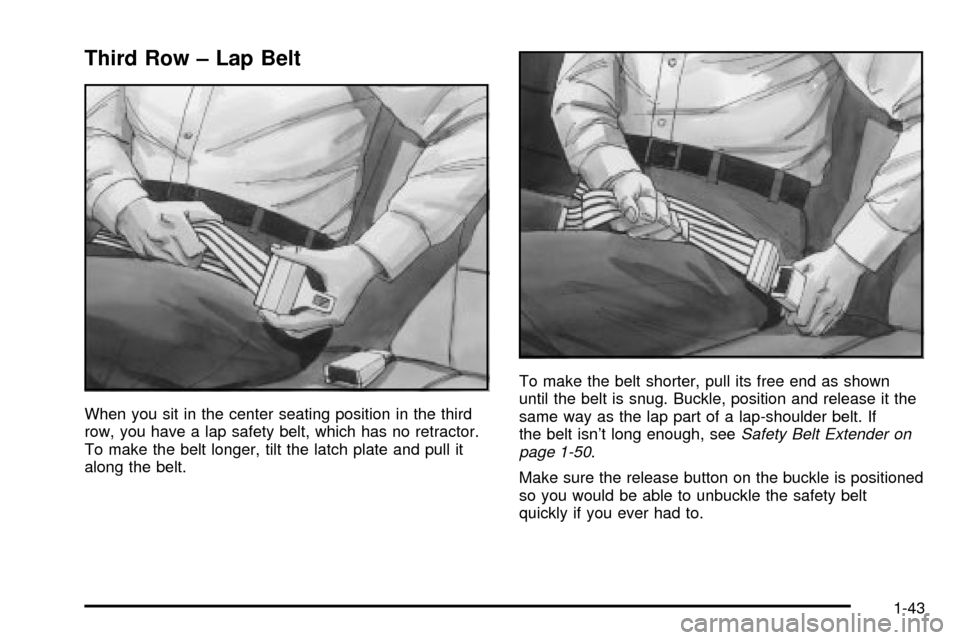
Third Row ± Lap Belt
When you sit in the center seating position in the third
row, you have a lap safety belt, which has no retractor.
To make the belt longer, tilt the latch plate and pull it
along the belt.To make the belt shorter, pull its free end as shown
until the belt is snug. Buckle, position and release it the
same way as the lap part of a lap-shoulder belt. If
the belt isn't long enough, see
Safety Belt Extender on
page 1-50.
Make sure the release button on the buckle is positioned
so you would be able to unbuckle the safety belt
quickly if you ever had to.
1-43
Page 51 of 486
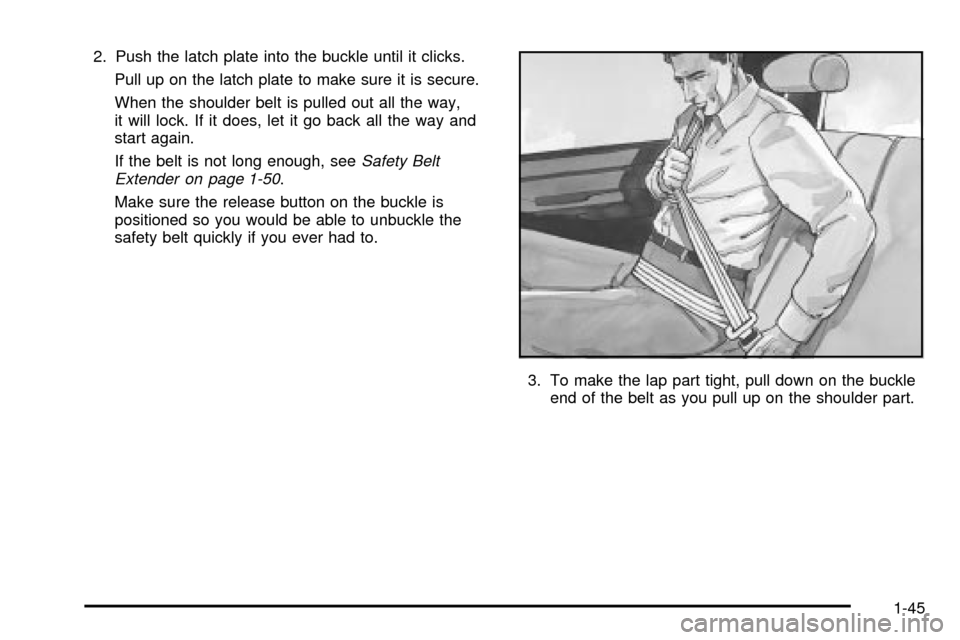
2. Push the latch plate into the buckle until it clicks.
Pull up on the latch plate to make sure it is secure.
When the shoulder belt is pulled out all the way,
it will lock. If it does, let it go back all the way and
start again.
If the belt is not long enough, see
Safety Belt
Extender on page 1-50.
Make sure the release button on the buckle is
positioned so you would be able to unbuckle the
safety belt quickly if you ever had to.
3. To make the lap part tight, pull down on the buckle
end of the belt as you pull up on the shoulder part.
1-45
Page 56 of 486

4. Buckle, position and release the safety belt as
described inRear Seat Passengers on page 1-44.
Make sure that the shoulder belt crosses the
shoulder.
To remove and store the comfort guides, squeeze the
belt edges together so that you can take them out of the
guides.
Safety Belt Extender
If the vehicle's safety belt will fasten around you, you
should use it.
But if a safety belt isn't long enough to fasten, your
dealer will order you an extender. It's free. When you go
in to order it, take the heaviest coat you will wear, so
the extender will be long enough for you. The extender
will be just for you, and just for the seat in your
vehicle that you choose. Don't let someone else use it,
and use it only for the seat it is made to ®t. To wear
it, just attach it to the regular safety belt.
Third Row Seat
1-50
Page 58 of 486

{CAUTION:
Never do this.
Here two children are wearing the same belt.
The belt can't properly spread the impact
forces. In a crash, the two children can be
crushed together and seriously injured. A belt
must be used by only one person at a time.
Q:What if a child is wearing a lap-shoulder belt,
but the child is so small that the shoulder belt
is very close to the child's face or neck?
A:If the child is sitting in a rear seat outside position,
move the child toward the center of the vehicle.
See
Rear Safety Belt Comfort Guides for Children
and Small Adults on page 1-47
. If the child is
sitting in the center position, move the child toward
the safety belt buckle. In either case, be sure
that the shoulder belt still is on the child's shoulder,
so that in a crash the child's upper body would
have the restraint that belts provide.
If the child is so small that the shoulder belt is still
very close to the child's face or neck, you might
want to place the child in a seat that has a lap belt,
if your vehicle has one.
1-52
Page 67 of 486
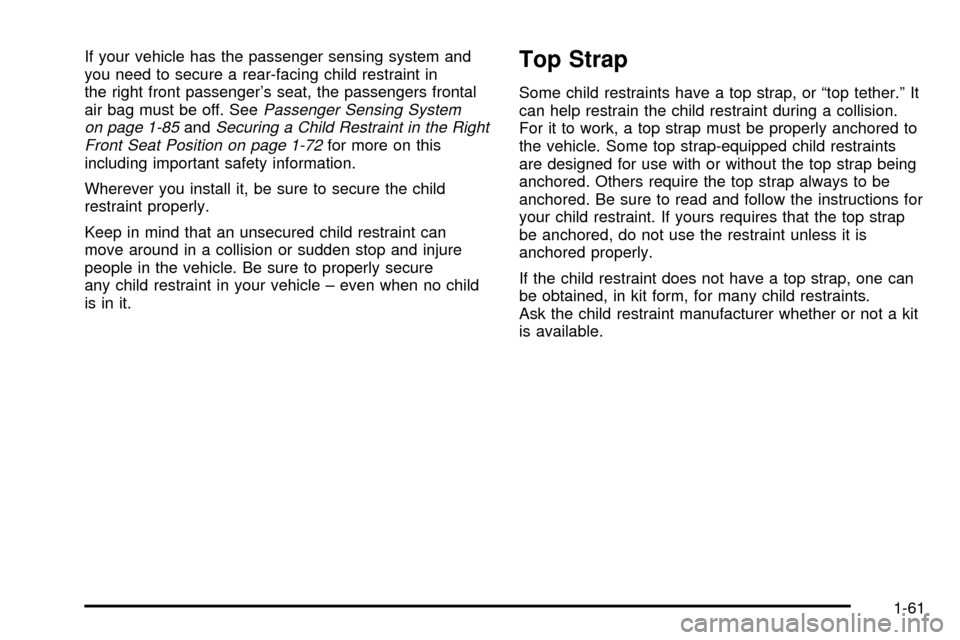
If your vehicle has the passenger sensing system and
you need to secure a rear-facing child restraint in
the right front passenger's seat, the passengers frontal
air bag must be off. See
Passenger Sensing System
on page 1-85andSecuring a Child Restraint in the Right
Front Seat Position on page 1-72for more on this
including important safety information.
Wherever you install it, be sure to secure the child
restraint properly.
Keep in mind that an unsecured child restraint can
move around in a collision or sudden stop and injure
people in the vehicle. Be sure to properly secure
any child restraint in your vehicle ± even when no child
is in it.
Top Strap
Some child restraints have a top strap, or ªtop tether.º It
can help restrain the child restraint during a collision.
For it to work, a top strap must be properly anchored to
the vehicle. Some top strap-equipped child restraints
are designed for use with or without the top strap being
anchored. Others require the top strap always to be
anchored. Be sure to read and follow the instructions for
your child restraint. If yours requires that the top strap
be anchored, do not use the restraint unless it is
anchored properly.
If the child restraint does not have a top strap, one can
be obtained, in kit form, for many child restraints.
Ask the child restraint manufacturer whether or not a kit
is available.
1-61
Page 68 of 486
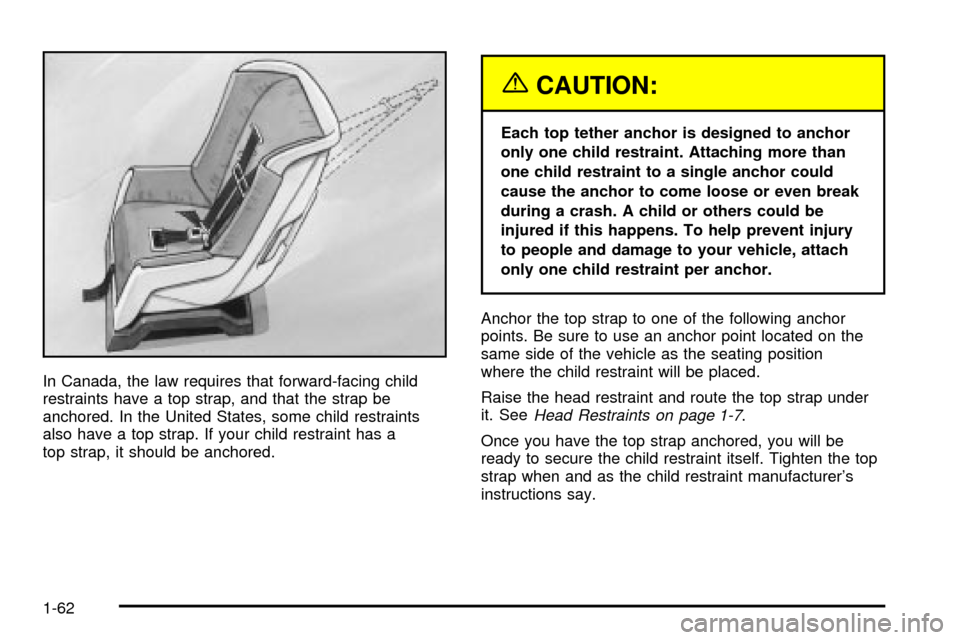
In Canada, the law requires that forward-facing child
restraints have a top strap, and that the strap be
anchored. In the United States, some child restraints
also have a top strap. If your child restraint has a
top strap, it should be anchored.
{CAUTION:
Each top tether anchor is designed to anchor
only one child restraint. Attaching more than
one child restraint to a single anchor could
cause the anchor to come loose or even break
during a crash. A child or others could be
injured if this happens. To help prevent injury
to people and damage to your vehicle, attach
only one child restraint per anchor.
Anchor the top strap to one of the following anchor
points. Be sure to use an anchor point located on the
same side of the vehicle as the seating position
where the child restraint will be placed.
Raise the head restraint and route the top strap under
it. See
Head Restraints on page 1-7.
Once you have the top strap anchored, you will be
ready to secure the child restraint itself. Tighten the top
strap when and as the child restraint manufacturer's
instructions say.
1-62
Page 73 of 486

Securing a Child Restraint Designed
for the LATCH System
1. Find the anchors for the seating position you want
to use, where the bottom of the seatback meets the
back of the seat cushion.
2. Put the child restraint on the seat.
3. Attach the anchor points on the child restraint to the
anchors in the vehicle. The child restraint
instructions will show you how.
4. If the child restraint is forward-facing, attach the top
strap to the top strap anchor. See
Top Strap on
page 1-61. Tighten the top strap according to
the child restraint instructions.
5. Push and pull the child restraint in different
directions to be sure it is secure.
To remove the child restraint, simply unhook the top
strap from the top tether anchor and then disconnect the
anchor points.
Securing a Child Restraint in a Rear
Outside Seat Position
If your child restraint is equipped with the LATCH
system, seeLower Anchorages and Top Tethers for
Children (LATCH System) on page 1-65. SeeTop Strap
on page 1-61if the child restraint has one.
1-67
Page 76 of 486
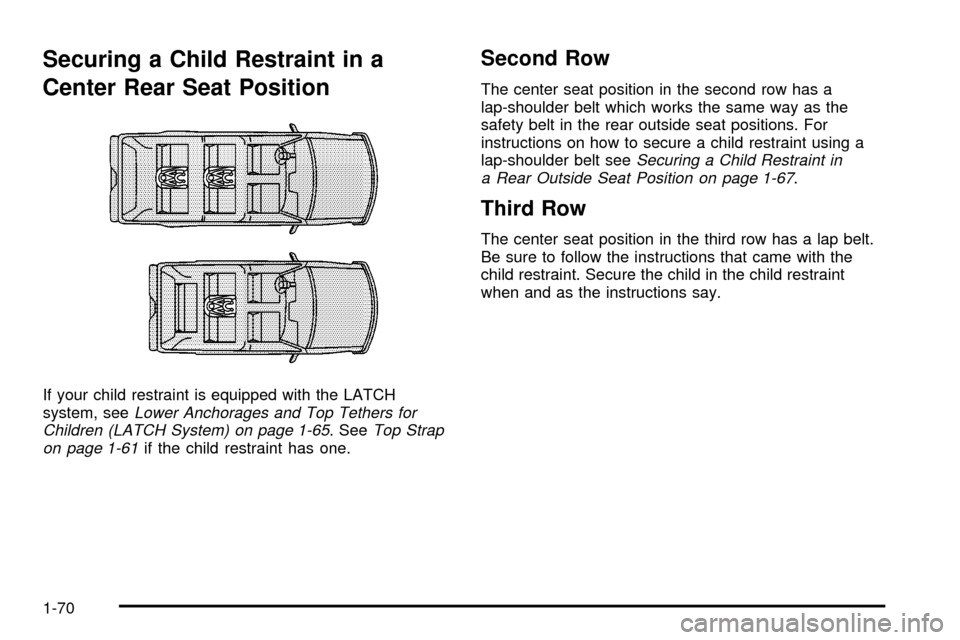
Securing a Child Restraint in a
Center Rear Seat Position
If your child restraint is equipped with the LATCH
system, seeLower Anchorages and Top Tethers for
Children (LATCH System) on page 1-65. SeeTop Strap
on page 1-61if the child restraint has one.
Second Row
The center seat position in the second row has a
lap-shoulder belt which works the same way as the
safety belt in the rear outside seat positions. For
instructions on how to secure a child restraint using a
lap-shoulder belt see
Securing a Child Restraint in
a Rear Outside Seat Position on page 1-67.
Third Row
The center seat position in the third row has a lap belt.
Be sure to follow the instructions that came with the
child restraint. Secure the child in the child restraint
when and as the instructions say.
1-70
Page 78 of 486
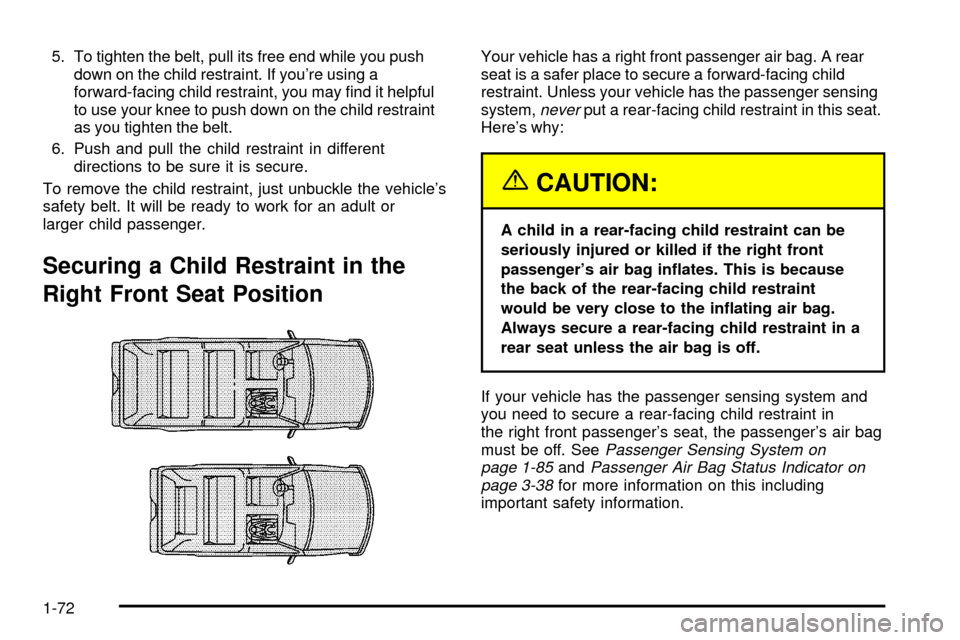
5. To tighten the belt, pull its free end while you push
down on the child restraint. If you're using a
forward-facing child restraint, you may ®nd it helpful
to use your knee to push down on the child restraint
as you tighten the belt.
6. Push and pull the child restraint in different
directions to be sure it is secure.
To remove the child restraint, just unbuckle the vehicle's
safety belt. It will be ready to work for an adult or
larger child passenger.
Securing a Child Restraint in the
Right Front Seat Position
Your vehicle has a right front passenger air bag. A rear
seat is a safer place to secure a forward-facing child
restraint. Unless your vehicle has the passenger sensing
system,
neverput a rear-facing child restraint in this seat.
Here's why:
{CAUTION:
A child in a rear-facing child restraint can be
seriously injured or killed if the right front
passenger's air bag in¯ates. This is because
the back of the rear-facing child restraint
would be very close to the in¯ating air bag.
Always secure a rear-facing child restraint in a
rear seat unless the air bag is off.
If your vehicle has the passenger sensing system and
you need to secure a rear-facing child restraint in
the right front passenger's seat, the passenger's air bag
must be off. See
Passenger Sensing System on
page 1-85andPassenger Air Bag Status Indicator on
page 3-38for more information on this including
important safety information.
1-72
Page 79 of 486

{CAUTION:
A child in a rear-facing child restraint can be
seriously injured or killed if the right front
passenger's air bag in¯ates. This is because
the back of the rear facing child restraint
would be very close to the in¯ating air bag. Be
sure the air bag is off before using a
rear-facing child restraint in the right front seat
position.
Even though the passenger sensing system is
designed to turn off the passenger's frontal air
bag if the system detects a rear-facing child
restraint, no system is fail-safe, and no one
can guarantee that an air bag will not deploy
under some unusual circumstance, even
though it is turned off. General Motors
therefore recommends that rear-facing child
restraints be secured in the rear seat whenever
possible, even if the air bag is off.You'll be using the lap-shoulder belt. See
Top Strap on
page 1-61if the child restraint has one. Be sure to
follow the instructions that came with the child restraint.
Secure the child in the child restraint when and as
the instructions say.
1. Because your vehicle has a right front passenger
air bag, always move the seat as far back as it will
go before securing a child restraint, if you need
to secure a forward-facing child restraint in the right
front seat position. See
Power Seats on page 1-3.
If your vehicle has the passenger sensing
system and you are using a rear-facing child
restraint in this seat, make sure the frontal air bag
is off. See
Passenger Sensing System on
page 1-85.
When the passenger sensing system has turned off
the right front passenger's frontal air bag, the off
indicator on the inside rearview mirror will be lit and
stay lit when you turn the ignition to RUN or START.
2. Put the restraint on the seat.
3. Pick up the latch plate, and run the lap and shoulder
portions of the vehicle's safety belt through or
around the restraint. The child restraint instructions
will show you how.
1-73